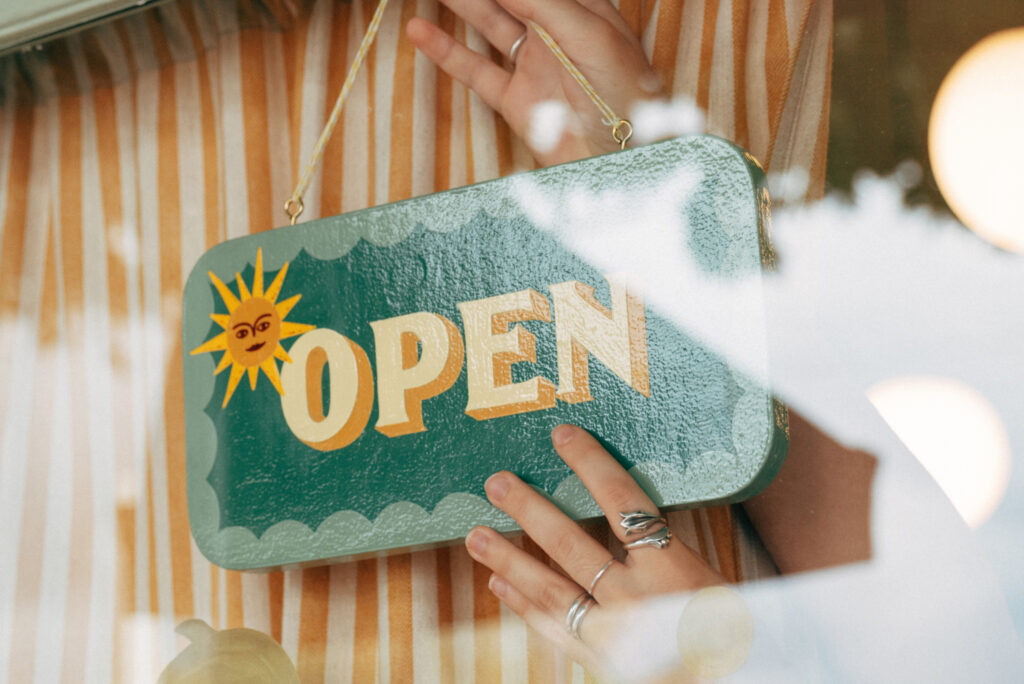
Highlights
- Create personal experiences with custom book recommendations and by throwing special events
- Tailor your inventory based on your community’s preferences
- Encourage impulse buys by stocking more than just books

A bookstore can be so much more than just a place to buy books—though stacks of enticing reads are the main draw, of course. Bookstores are often community hubs where everyone is welcome: a cozy, inspiring place that brings people together. A great location and the right titles are important to a successful bookstore, but there’s more to the equation when you’re trying to stand out as a small business.
By focusing on personalized customer service, curating a unique inventory that resonates with individual and local tastes, and hosting engaging events, your bookstore can become a cherished third place in the community.
But how do you actually get started and open a bookstore? Read on for details.
Opening a book shop: The 9 steps you need to take
Step one: Determine your concept and target market
What kind of bookstore do you want to open? Clearly define your concept and do your homework to learn about local demographics, identify competitors, and evaluate demand. You could skew more traditional or lean into rare/vintage books, comic books, a specific audience (like children), or certain genres (i.e., science fiction).
Step two: Make a business plan
Develop a detailed business plan outlining your store’s goals, strategies, and financial projections. How much capital you’ll need to raise will depend on multiple factors, but two major costs are likely to be rent and inventory.
Step three: Get your paperwork in order
Streamline the paperwork process when applying for permits, licenses, taxes, and your business registration. Consult a tax professional to understand your tax obligations and apply for any necessary loans.
Step four: Find a location
Choose a location with good foot traffic and community appeal, or develop a solid website to reach a wider audience online (or do both).
Step five: Plan your layout and merchandising
If you’re going with a brick-and-mortar store, you’ll want to design an inviting layout that enhances your customers’ experience.
Step six: Buy inventory and stay on budget
Research and select inventory that aligns with your niche and customer preferences. Budget accordingly and consider expanding your inventory beyond books.
Step seven: Plan your operations, POS System, and staffing
Implement an efficient POS system for seamless transactions, and hire knowledgeable staff who share your love for books and can offer personalized recommendations.
Step eight: Open your doors
Plan a grand-opening event that highlights your bookstore’s unique offerings and fosters excitement within the community. Consider partnering with local businesses for joint promotions.
Step nine: Promote your store
Develop a marketing plan that includes social media, email campaigns, and local advertisements to spread the word about your new bookstore. Host events and engage with the community to build a strong customer base.
Brick-and-mortar or e-commerce: Which model is right for you?
Opening a physical bookshop offers distinct advantages, such as the ability to create a sensory-rich environment that invites customers to linger. This allows for personal interactions and community engagement, key elements that are challenging to replicate online. But a brick-and-mortar store also requires significant overhead costs, including rent and utilities. Many brick-and-mortar stores test the waters with a pop-up shop, which helps you build a strong foundation before investing in a bigger space.
Conversely, online bookstores offer a broader market reach, lower overhead costs, and more flexibility in inventory management. They’re also easier to scale. However, they do lack the personal touch inherent in physical stores.
Integrate a café space
Opening a bookstore café can significantly enhance the customer experience, encouraging visitors to stay longer and increase their chances of making a purchase. This provides a comfortable setting where patrons can relax, read, and socialize.
But opening a bookstore café involves a few more variables, such as health regulations, kitchen equipment, and staffing. It’s crucial to design the space so that the café and bookstore elements complement each other, ensuring a seamless flow between browsing and dining areas.
Curating your inventory
Conduct market research
Start by analyzing the demographics and preferences of the community where you plan to open your bookstore. Survey potential customers, visit local competitors, and review sales data from similar markets to identify popular genres and emerging trends.
Especially for smaller bookstores, it’s wise to buy minimum quantities of everything (unless you know it’s a super popular title that everyone’s reading) so you can control your start-up inventory and offer a greater variety of options.
Engage with the community through social media platforms and local events to gather insights into their reading habits and interests. Consider organizing focus groups or online polls to directly involve future patrons in the decision-making process. This proactive approach helps determine the demand for specific genres, authors, or themes, allowing you to tailor your offerings accordingly.
Stock diverse merchandise
Offering a variety of products beyond books—such as stationery, gifts, and literary-themed items—can attract different types of shoppers and encourage impulse buys. By thoughtfully diversifying your merchandise, you create a richer shopping experience that goes beyond the books themselves.
- Consider bookmarks, calendars, and reading lights.
- Dip into the world of crafts, from lip-balm kits to crochet accessories and block–printing essentials.
- Puzzles of all sorts are often a big hit for every age.
- Don’t sleep on stationery, like paper goods, pens, notebooks, and the like.
- Magnets, stickers, and patches are an easy impulse buy.
- Local and artisanal products support fellow small businesses and neighbors.
To effectively merchandise your products, use varied displays and grouping techniques. Arrange items on tables and shelves in thematic collections to create visually appealing setups that invite exploration. For example, complement cookbooks with kitchen gadgets or pair travel guides with maps and travel accessories. This can inspire customers to purchase multiple items and impromptu gifts.
Building community connections
Host engaging events
By offering a vibrant calendar of events, your bookstore transforms into a lively cultural hub where people gather, share ideas, and celebrate their love for literature. Connect with local authors, schools, and organizations to co-host events, and consider hosting cross-promotional gatherings, like a book reading paired with a local café’s coffee tasting. These collaborations not only attract diverse customer bases but also enrich the cultural fabric of your community. Seasonal or holiday-themed events also go a long way to capitalize on increased foot traffic and contribute to the festive atmosphere.
Offer personalized recommendations
By getting to know your customers’ preferences and interests, you can provide tailored suggestions that enhance their experience and demonstrate your commitment to meeting their needs. Hire bookish staff and train them to have meaningful conversations with customers, including asking insightful questions about their reading habits and favorite genres. Encourage them to share their own book passions, creating a genuine exchange that builds trust.
You can also utilize technology to track customer purchases and preferences, allowing for more accurate and personalized recommendations during future visits. Display staff picks and customer favorites prominently in the store, providing a curated selection that guides readers to discover new titles.
Grow alongside the community
To compete with big chains, you have to focus on what independent bookstores do best: offering personalized experiences and fostering a sense of community. Unlike large retailers, your bookstore can provide tailored recommendations and engage with customers on a personal level, creating real relationships that mean more than online transactions.Emphasize the quality of experience over quantity, ensuring each visit is memorable and enjoyable. Expect the unexpected and remember to listen to your customers and allow their input to shape where your business goes. Get involved where you can, and try to contribute locally as your business evolves and finds its spot in your community.




